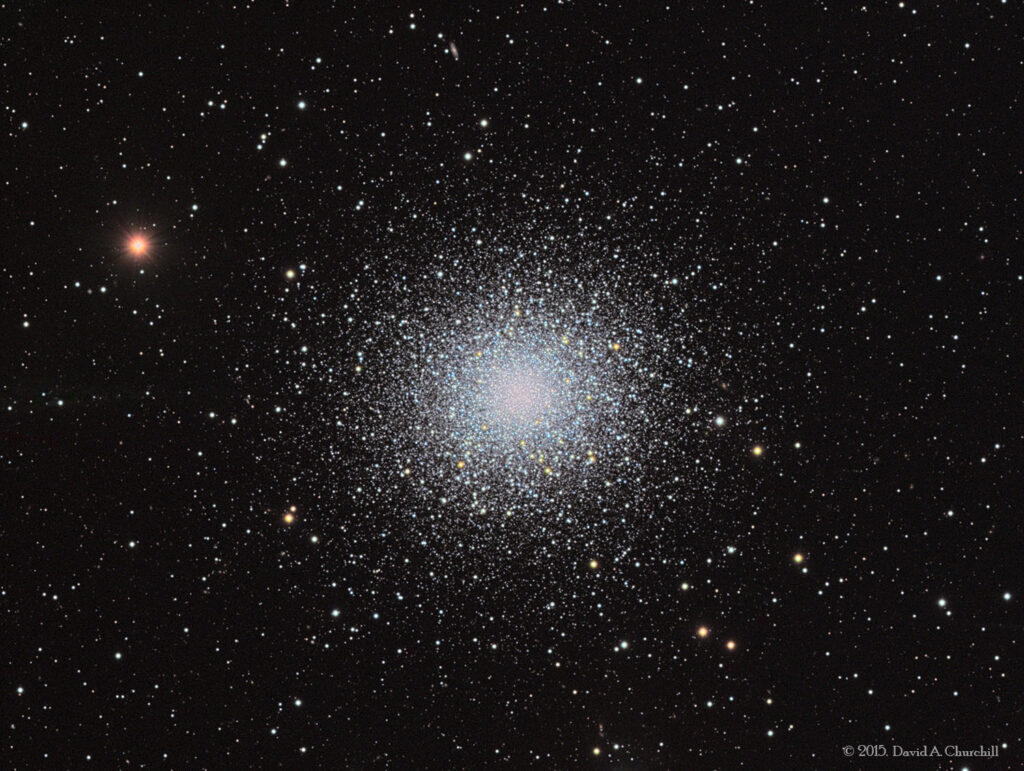Messier 13
Globular Cluster, Hercules
- Description
- Technical
- Links
M13 was discovered by Edmond Halley in 1714, and cataloged by Charles Messier on June 1, 1764, into his list of objects not to mistake for comets; Messier’s list, including Messier 13, eventually became known as the Messier Catalog.
About one third of the way from Vega to Arcturus, four bright stars in Herculēs form the Keystone asterism, the broad torso of the hero. M13 can be seen in this asterism 2⁄3 of the way north (by west) from Zeta to Eta Herculis. Although only telescopes with great light-gathering capability fully resolve the stars of the cluster, M13 may be visible to the naked eye depending on circumstances. With a low-power telescope, Messier 13 looks like a comet or fuzzy patch. The cluster is visible throughout the year from latitudes greater than 36 degrees north, with the longest visibility during Northern Hemisphere spring and summer.
It is located at right ascension 16h 41.7m, declination +36° 28′. With an apparent magnitude of 5.8, it is barely visible with the naked eye on clear nights. Its diameter is about 23 arcminutes and it is readily viewable in small telescopes. Nearby is NGC 6207, a 12th-magnitude edge-on galaxy that lies 28 arcminutes directly northeast. A small galaxy, IC 4617, lies halfway between NGC 6207 and M13, north-northeast of the large globular cluster’s center.
In traditional binoculars, the Hercules Globular Cluster appears as a round patch of light. At least four inches of telescope aperture resolves stars in M13’s outer extent as small pinpoints of light. However, only larger telescopes resolve stars further into the center of the cluster.
About 145 light-years in diameter, M13 is composed of several hundred thousand stars, the brightest of which is a red giant, the variable star V11, also known as V1554 Herculis, with an apparent visual magnitude of 11.95. M13 is 22,200–25,000 light-years away from Earth.
Single stars in this globular cluster were first resolved in 1779. Compared to the stars in the neighborhood of the Sun, the stars of the M13 population are more than a hundred times more densely packed. They are so close together that they sometimes collide and produce new stars. The newly formed, young stars, so-called “blue stragglers”, are particularly interesting to astronomers.
The 1974 Arecibo message, which contained encoded information about the human race, DNA, atomic numbers, Earth’s position and other information, was beamed from the Arecibo Observatory radio telescope towards M13 as an experiment in contacting potential extraterrestrial civilizations in the cluster. The cluster will move through space during the transit time; opinions differ as to whether or not the cluster will be in a position to receive the message by the time that it arrives.
Telescope: Astro Physics 175EDF f8.3
Mount: Astro Physics 3600GTO “El Capitan”
Camera: SBIG STT8300
Guider: Mini Borg 50 / SBIG STi
L: 12×10 mins = 120 mins, R: 6×10 mins = 60 mins, G: 6×10 mins = 60 mins, B: 6×10 mins = 60 mins
Total Imaging Time: 5h 00m
Data Imaged remotely over 1 night during June 2015.
Data acquisition & Processing by David Churchill.
None

